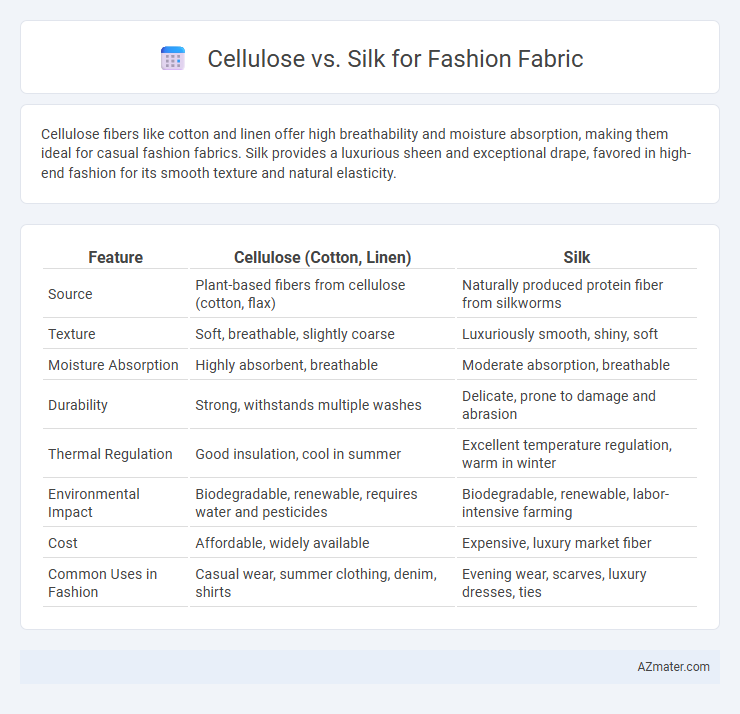Cellulose fibers like cotton and linen offer high breathability and moisture absorption, making them ideal for casual fashion fabrics. Silk provides a luxurious sheen and exceptional drape, favored in high-end fashion for its smooth texture and natural elasticity.
Table of Comparison
| Feature | Cellulose (Cotton, Linen) | Silk |
|---|---|---|
| Source | Plant-based fibers from cellulose (cotton, flax) | Naturally produced protein fiber from silkworms |
| Texture | Soft, breathable, slightly coarse | Luxuriously smooth, shiny, soft |
| Moisture Absorption | Highly absorbent, breathable | Moderate absorption, breathable |
| Durability | Strong, withstands multiple washes | Delicate, prone to damage and abrasion |
| Thermal Regulation | Good insulation, cool in summer | Excellent temperature regulation, warm in winter |
| Environmental Impact | Biodegradable, renewable, requires water and pesticides | Biodegradable, renewable, labor-intensive farming |
| Cost | Affordable, widely available | Expensive, luxury market fiber |
| Common Uses in Fashion | Casual wear, summer clothing, denim, shirts | Evening wear, scarves, luxury dresses, ties |
Introduction to Cellulose and Silk Fabrics
Cellulose fabrics, derived from natural plant fibers such as cotton, linen, and rayon, offer breathability, moisture absorption, and biodegradability, making them sustainable options in fashion. Silk, produced from silkworm cocoons, is prized for its luxurious texture, natural sheen, and excellent drape, providing elegance and comfort in high-end garments. Understanding the distinct properties of cellulose and silk fabrics enables designers to select suitable materials based on durability, aesthetic appeal, and environmental impact.
Origins and Production Processes
Cellulose fibers, derived primarily from plants like cotton and bamboo, undergo processes such as retting, crushing, or chemical treatments to extract fibers suitable for fabric production. Silk originates from silkworm cocoons, produced through sericulture, where fibers are carefully harvested and spun to preserve their strength and natural sheen. The production of cellulose fabrics typically involves mechanical or chemical extraction methods, whereas silk production is labor-intensive, requiring delicate reeling and degumming to yield the luxurious textile favored in high-end fashion.
Environmental Impact: Sustainability and Eco-friendliness
Cellulose fibers like cotton and lyocell boast high sustainability due to their biodegradability and renewable plant-based sources, making them eco-friendly choices in fashion fabric. Silk, derived from silkworms, presents a natural and biodegradable material but involves ethical concerns and higher water and energy consumption during production. Considering environmental impact, cellulose fabrics generally offer a lower carbon footprint and reduced resource usage compared to traditional silk, aligning better with sustainable fashion goals.
Texture and Comfort Comparison
Cellulose fabrics, derived from plant fibers like cotton and rayon, offer a soft, breathable texture ideal for comfort in hot climates. Silk, a natural protein fiber produced by silkworms, provides a smooth, luxurious feel with excellent drape but tends to be less breathable than cellulose-based materials. The choice between cellulose and silk hinges on the desired balance of moisture-wicking properties and tactile elegance in fashion fabric.
Durability and Longevity in Fashion
Cellulose fibers, such as cotton and viscose, offer high durability and resistance to wear, making them ideal for everyday fashion fabrics that require long-lasting performance. Silk, a protein-based fiber, provides exceptional strength combined with a luxurious texture but tends to be more delicate and susceptible to abrasion and sunlight damage over time. For fashion applications prioritizing longevity and resilience, cellulose fabrics generally outperform silk in maintaining structural integrity through repeated use and washing.
Breathability and Moisture Management
Cellulose fibers like cotton and modal excel in breathability due to their natural hygroscopic properties, allowing air circulation and effective moisture absorption, which keeps the skin dry and comfortable. Silk, a protein-based fiber, offers moderate breathability with a smooth texture that helps wick moisture away but tends to retain heat more than cellulose fabrics. Fashion designers prioritize cellulose fabrics for summer collections due to superior moisture management, while silk is favored for luxury garments requiring moderate moisture control and a lustrous finish.
Dyeability and Color Retention
Cellulose fibers like cotton and rayon exhibit excellent dyeability due to their hydrophilic nature, allowing vibrant and diverse color applications. Silk, a protein fiber, offers rich dye absorption with superior luster, resulting in vivid color depth but may experience slight fading over time. Both fabrics retain color effectively when treated properly, but silk requires more delicate care to maintain long-term vibrancy compared to cellulose fibers.
Cost and Availability in the Market
Cellulose fabrics like rayon and lyocell offer a more affordable and widely available alternative to silk, thanks to their production from abundant natural sources such as wood pulp. Silk, derived from silkworm cocoons, remains costly due to labor-intensive harvesting and limited supply, driving higher prices in luxury fashion markets. The consistent and scalable manufacturing of cellulose fibers results in greater market accessibility, making them a popular choice for budget-conscious designers and consumers.
Care and Maintenance Requirements
Cellulose fabrics like cotton and linen require frequent washing and careful drying to prevent shrinkage and maintain fiber strength, often needing gentle detergents and avoiding high heat. Silk demands delicate handling with gentle hand washing or dry cleaning, using mild detergents and avoiding direct sunlight to preserve its natural luster and prevent fiber damage. Proper storage in a cool, dry place away from harsh chemicals is essential for both materials to extend garment lifespan and maintain fabric quality.
Suitability for Trending Fashion Styles
Cellulose fibers like viscose and lyocell offer breathability, moisture-wicking properties, and a smooth drape that align well with eco-conscious and casual-chic fashion trends. Silk provides a luxurious sheen, natural elasticity, and a lightweight feel, making it ideal for high-end, elegant, and evening wear styles. Trending fashion increasingly favors sustainable cellulose fabrics for their versatility, while silk remains a staple for premium designs emphasizing sophistication and texture.

Infographic: Cellulose vs Silk for Fashion fabric
 azmater.com
azmater.com